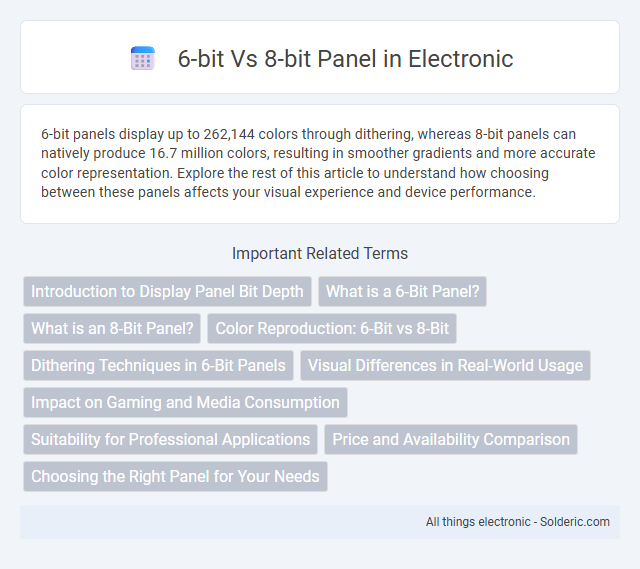6-bit panels display up to 262,144 colors through dithering, whereas 8-bit panels can natively produce 16.7 million colors, resulting in smoother gradients and more accurate color representation. Explore the rest of this article to understand how choosing between these panels affects your visual experience and device performance.
Comparison Table
| Feature | 6-bit Panel | 8-bit Panel |
|---|---|---|
| Color Depth | 64 colors per channel (262K total colors) | 256 colors per channel (16.7 million total colors) |
| Color Accuracy | Lower, visible banding | Higher, smooth gradients |
| Common Use | Budget monitors, basic office use | Professional, gaming, photo editing |
| Image Quality | Adequate for non-critical tasks | Superior with rich color detail |
| Price | More affordable | Typically higher cost |
Introduction to Display Panel Bit Depth
Display panel bit depth defines the number of color shades a screen can reproduce, significantly impacting image quality. A 6-bit panel displays 64 colors per channel, totaling approximately 262,144 colors, while an 8-bit panel can render 256 colors per channel, reaching over 16 million colors for smoother gradients and more accurate visuals. Choosing between 6-bit and 8-bit panels affects Your viewing experience, especially in color-critical applications like photo editing and high-definition video playback.
What is a 6-Bit Panel?
A 6-bit panel uses 6 bits per color channel, allowing it to display 262,144 colors, which results in less color accuracy and smoother gradients compared to 8-bit panels. In contrast, an 8-bit panel supports 16.7 million colors by using 8 bits per channel, providing richer color depth and more precise image reproduction. The limited color range of 6-bit panels often leads to banding effects in images with subtle color transitions.
What is an 8-Bit Panel?
An 8-bit panel refers to a display capable of producing 16.7 million colors by utilizing 8 bits per color channel (red, green, and blue), which results in smoother gradients and more accurate color reproduction compared to a 6-bit panel. A 6-bit panel typically generates only 262,144 colors and relies on dithering techniques to simulate intermediate shades, often leading to color banding and less precise visuals. The higher color depth of an 8-bit panel is essential for tasks demanding superior color fidelity, such as professional photo editing and high-quality video playback.
Color Reproduction: 6-Bit vs 8-Bit
An 8-bit panel can display 16.7 million colors, providing smoother gradients and more accurate color reproduction compared to a 6-bit panel, which typically produces only 262,144 colors using dithering techniques to simulate intermediate shades. This difference in color depth is crucial for tasks requiring precise color representation, such as photo editing and graphic design. Your visual experience will be richer and more vibrant with an 8-bit display, delivering greater detail and reduced color banding.
Dithering Techniques in 6-Bit Panels
6-bit panels use dithering techniques like Frame Rate Control (FRC) to simulate 8-bit color depth by rapidly toggling pixels between shades, enhancing perceived color accuracy and reducing banding. These dithering methods compensate for the limited color range in 6-bit panels, allowing your display to render smoother gradients and more vibrant images despite hardware constraints. However, 8-bit panels naturally produce richer and more consistent colors without relying on such processing tricks.
Visual Differences in Real-World Usage
6-bit panels use dithering techniques to simulate 16.7 million colors, resulting in potential banding and less smooth color gradients compared to true 8-bit panels, which can display 16.7 million distinct colors without dithering. In real-world usage, 8-bit panels offer richer and more accurate color representation, making them ideal for photo editing, gaming, and media consumption where visual fidelity is crucial. Users may notice smoother transitions and improved color depth on 8-bit displays, whereas 6-bit panels are more prone to color inconsistencies and subtle artifacts in complex images.
Impact on Gaming and Media Consumption
A 6-bit panel displays 262,144 colors, while an 8-bit panel can show 16.7 million colors, resulting in significantly richer and more accurate visuals for gaming and media consumption. Your gaming experience benefits from smoother gradients and reduced color banding on an 8-bit panel, enhancing immersion in detailed graphics and cutscenes. Media consumption, especially HDR content, looks more vibrant and lifelike on an 8-bit display, providing a superior viewing experience compared to the limited color range of a 6-bit panel.
Suitability for Professional Applications
8-bit panels deliver 16.7 million colors, offering sufficient color accuracy for general multimedia and web content creation, while 6-bit panels produce only 262,000 colors, often relying on dithering to approximate more shades. Professional applications such as photo editing, graphic design, and video production demand precise color representation, making 8-bit panels significantly more suitable due to their ability to display smoother gradients and finer detail. High-end monitors may also feature 10-bit panels, but among 6-bit and 8-bit options, 8-bit is preferred for professional workflows requiring accurate and consistent color output.
Price and Availability Comparison
6-bit panels typically come at a lower price point due to their simpler technology and are widely available in budget monitors and entry-level laptops. In contrast, 8-bit panels offer superior color depth and accuracy, resulting in higher costs and may be less common in lower-priced models but are prevalent in mid-range to high-end displays. Availability of 8-bit panels has increased with demand for better visual quality in gaming and professional applications, although 6-bit remains dominant in cost-sensitive markets.
Choosing the Right Panel for Your Needs
When selecting between a 6-bit and 8-bit panel, prioritize color depth and image quality based on your usage. An 8-bit panel displays 16.7 million colors, offering smoother gradients and richer visuals compared to a 6-bit panel's 262,144 colors, which may cause banding effects. For professional photo editing, gaming, or multimedia consumption, 8-bit panels provide superior performance, whereas 6-bit panels can suffice for basic office tasks or casual browsing.
6-bit vs 8-bit Panel Infographic

 solderic.com
solderic.com